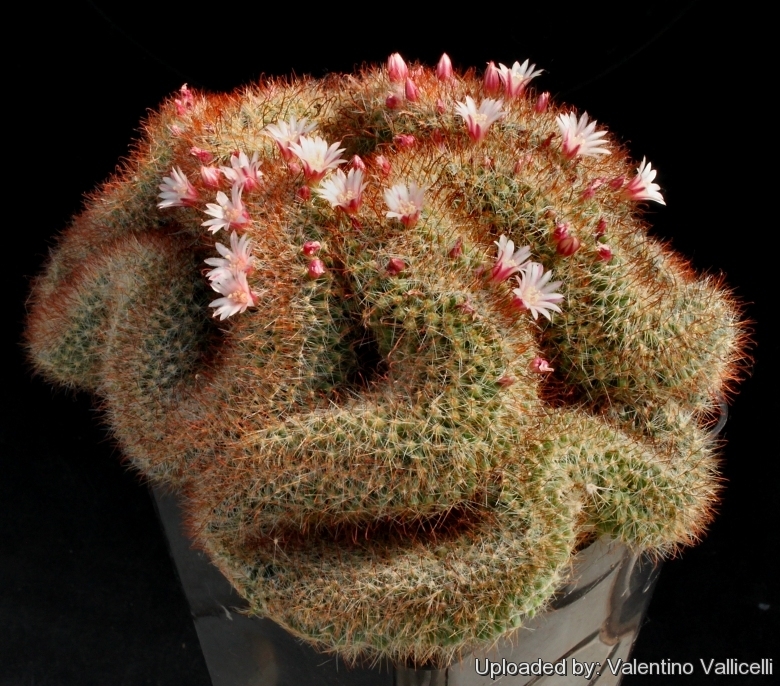
Mammillaria wildii f. cristata Photo by: Valentino Vallicelli
Showy and easy to grow, it will form huge flowering mounds up 40cm (or more) in diameter.
Origin and Habitat: Garden origin (Nursery produced selection)
Synonyms:
See all synonyms of Mammillaria wildii
Common Names include:
ENGLISH: Brain cactus
Description: This is a nice crested plant particularly appreciated by collector for its free blooming habit. It can form large tangled, brain like mounds in few years.
Central spines: Short brownish yellow hooked, minutely pubescent like in the normal form.
Radial spines: 1 to 15, whitish, smooth, 4 to 5 mm long.
Flowers: Creamy or pale brownish-yellow, to about 14 mm in diameter. Stigmas greenish white.
Fruits: Red.
Subspecies, varieties, forms and cultivars of plants belonging to the Mammillaria crinita complex
 Mammillaria aurihamata Boed.: has golden yellow hooked central spines. Distribution: Mexico, where it occurs in San Luis Potosi, near Real de Catorce.
Mammillaria aurihamata Boed.: has golden yellow hooked central spines. Distribution: Mexico, where it occurs in San Luis Potosi, near Real de Catorce.  Mammillaria brevicrinita Repp.: (Mammillaria crinita) Radial spines 10 - 29, white, finely pubescent, 6 - 9 mm long.
Mammillaria brevicrinita Repp.: (Mammillaria crinita) Radial spines 10 - 29, white, finely pubescent, 6 - 9 mm long.
Central spines: 0 - 7, awl-shaped, yellowish to red to dark brown, 8-16 mm long, one or two hooked.- Mammillaria crinita DC.: This taxon comprises a very variable a complex of forms, variety and species with varible spination. The flowers cream colored to a pink-cream colored. This is one of the most prolific bloomers among the Mammillarias.
 Mammillaria crinita subs. duwei (Rogoz. & P.J.Braun): It is a small cactus with delicate near harmless feathery spines densely wrapped against the body of the cactus. The long central spine is not present on all the clones, they are yellowish, hooked, to 8 mm long, pubescent. The flowers are yellowish/cream to light yellow.
Mammillaria crinita subs. duwei (Rogoz. & P.J.Braun): It is a small cactus with delicate near harmless feathery spines densely wrapped against the body of the cactus. The long central spine is not present on all the clones, they are yellowish, hooked, to 8 mm long, pubescent. The flowers are yellowish/cream to light yellow. Mammillaria crinita subs. duwei f. cristata hort.: crested form completely covered by tight pubescent spines.
Mammillaria crinita subs. duwei f. cristata hort.: crested form completely covered by tight pubescent spines. Mammillaria crinita subs. duwei f. inermis hort.: this is a selected strain with pure feathery radial spines (central spines absent)
Mammillaria crinita subs. duwei f. inermis hort.: this is a selected strain with pure feathery radial spines (central spines absent) Mammillaria crinita subs. duwei f. monstruosa hort.: This is a true oddity and some say that this monster is nothing else than a abnormal root grafted upside down.
Mammillaria crinita subs. duwei f. monstruosa hort.: This is a true oddity and some say that this monster is nothing else than a abnormal root grafted upside down.- Mammillaria crinita f. nana (Backeb.)
- Mammillaria crinita subs. painteri (Rose) U.Guzmán: has red, brown or coffee coloured central spines. With age it may offset from the base to form a small cluster. Distribution: Queretaro and adjacent areas in Hidalgo and Guanajuato.
 Mammillaria crinita subs. painteri f. monstruosa cristata hort.: Crested form. has more bristly spines than the Mammillaria crinita subs. painteri f. monstruosa from which it derives.
Mammillaria crinita subs. painteri f. monstruosa cristata hort.: Crested form. has more bristly spines than the Mammillaria crinita subs. painteri f. monstruosa from which it derives. Mammillaria crinita subs. painteri f. monstruosa hort.: Cultivated mutant characterized by very reduced or absent spines, free branching, and with small pink flowers.
Mammillaria crinita subs. painteri f. monstruosa hort.: Cultivated mutant characterized by very reduced or absent spines, free branching, and with small pink flowers. Mammillaria glochidiata var. xiloensis Repp.: (Mammillaria crinita) Plants irregularly forming tightly packed cluster of egg-shaped balls, up to 5 cm tall with dark yellow fine hooklike spines and pale cream-pink flowers.
Mammillaria glochidiata var. xiloensis Repp.: (Mammillaria crinita) Plants irregularly forming tightly packed cluster of egg-shaped balls, up to 5 cm tall with dark yellow fine hooklike spines and pale cream-pink flowers.- Mammillaria monancistracantha Backeb.: (Mammillaria crinita f. nana)
 Mammillaria scheinvariana R.Ortega V. & Glass: (Mammillaria crinita) Stem covered by numerous hairlike radial spines, giving the plant a shaggy appearance.
Mammillaria scheinvariana R.Ortega V. & Glass: (Mammillaria crinita) Stem covered by numerous hairlike radial spines, giving the plant a shaggy appearance. Mammillaria tezontle W.A.Fitz Maur. & B.Fitz Maur.: has small stems only 1-2 cm in diameter with short, yellow central spination and relatively large flowers. Distribution: North of San Luis Potosi.
Mammillaria tezontle W.A.Fitz Maur. & B.Fitz Maur.: has small stems only 1-2 cm in diameter with short, yellow central spination and relatively large flowers. Distribution: North of San Luis Potosi. Mammillaria trichacantha K.Schum.: (Mammillaria crinita f. nana) It his is a remarkable species on account of its having short hooked brown to yellow/orangish spines that finally turn to gray.
Mammillaria trichacantha K.Schum.: (Mammillaria crinita f. nana) It his is a remarkable species on account of its having short hooked brown to yellow/orangish spines that finally turn to gray.- Mammillaria wildii A.Dietr.: (Mammillaria crinita ssp. wildii) Short brownish to yellow hooked, minutely pubescent central spines and 1 to 15, whitish, smooth, 4 to 5 mm long radials.
 Mammillaria wildii f. cristata hort.: (Mammillaria crinita ssp wildii "cristata") It will form huge crested and free flowering mounds up 40 cm (or more) in diameter.
Mammillaria wildii f. cristata hort.: (Mammillaria crinita ssp wildii "cristata") It will form huge crested and free flowering mounds up 40 cm (or more) in diameter. Mammillaria zeilmanniana Boed.: has flowers typically carmine violet to purple-pink in color, seldom white. Distribution: San Miguel de Allende in Cañada Virgen, Guanajuato.
Mammillaria zeilmanniana Boed.: has flowers typically carmine violet to purple-pink in color, seldom white. Distribution: San Miguel de Allende in Cañada Virgen, Guanajuato. Mammillaria zeilmanniana f. albiflora hort.: is a white flowered sport that was produced in cultivation and not known to occur in the wild.
Mammillaria zeilmanniana f. albiflora hort.: is a white flowered sport that was produced in cultivation and not known to occur in the wild.
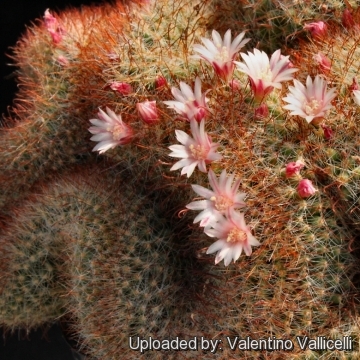 Mammillaria wildii f. cristata Photo by: Valentino Vallicelli
Mammillaria wildii f. cristata Photo by: Valentino Vallicelli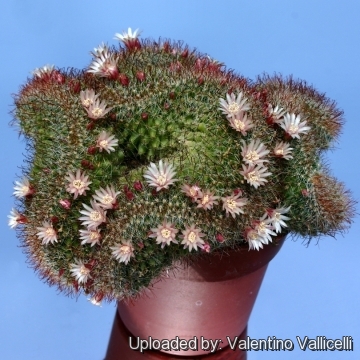 Mammillaria wildii f. cristata Photo by: Valentino Vallicelli
Mammillaria wildii f. cristata Photo by: Valentino Vallicelli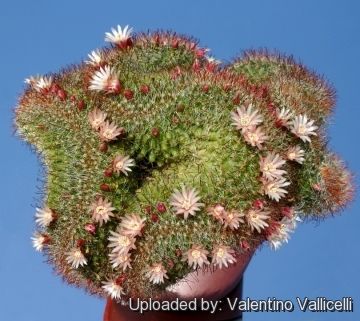 Mammillaria wildii f. cristata Photo by: Valentino Vallicelli
Mammillaria wildii f. cristata Photo by: Valentino Vallicelli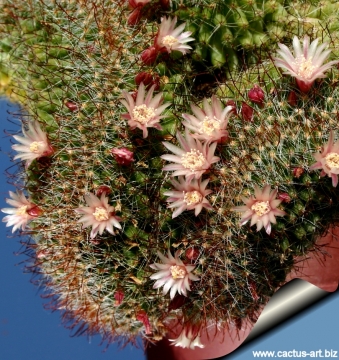 Mammillaria wildii f. cristata Photo by: Cactus Art
Mammillaria wildii f. cristata Photo by: Cactus ArtCultivation and Propagation: Its qualities and ease of cultivation justify its being an old favourite. It is sometime seen as a grafted plant but grows very well on its own roots too.
Soil: Use mineral well permeable mineral soil with little organic matter (peat, humus).
Exposure: They need a good amount of light shade to full sun this help to keep the plants healthy, although slow growth.
Watering: Water sparingly from March till October (weekly during summertime, if the weather is sunny enough) , with a little fertilizer added. Less or no water during cold winter months, or when night temperatures remain below 10° to prevent root loss. It is sensitive to overwatering (rot prone).
Fertilization: Feeding may not be necessary at all if the compost is fresh then, feed in summer only if the plant hasn't been repotted recently. Do not feed the plants from September onwards as this can cause lush growth which can be fatal during the darker cold months.
Hardiness: Keep perfectly dry in winter at temperatures from 5 to 15 degrees centigrade. (but it is relatively cold resistant and hardy to -5° C, or possibly colder for short periods) In the rest period no high atmospheric humidity!! (Temperature Zone: USDA 9-11)
Crested growth: Unlike 'monstrose' varieties of plants, where the variation from normal growth is due to genetic mutation, crested growth can occur on normal plants. Sometimes it's due to variances in light intensity, or damage, but generally the causes are unknown. A crested plant may have some areas growing normally, and a cresting plant that looks like a brain, may revert to normal growth for no apparent reason. If you have any of the crested part left you need to remove the normal growth and leave the crested part behind this will need to be done regularly.
Propagation: Grafting or cuttings. Plants are usually grafted onto column-shaped cacti but proved to be able to produce their own roots if degrafted. Cuttings will take root in a minimum temperature of 20° C (but better in hot weather). Cuttings of healthy shoots can be taken in the spring and summer. Cut the stem with a sharp, sterile knife, leave the cutting in a warm, dry place for a week or weeks (depending on how thick the cutting is) until a callus forms over the wound. Once the callus forms, the cutting may be inserted in a container filled with firmed cactus potting mix topped with a surface layer of coarse grit. They should be placed in the coarse grit only; this prevents the cut end from becoming too wet and allows the roots to penetrate the rich compost underneath. The cuttings should root in 2 to 6 weeks. Large crested piece must be placed on the soil surface without burying the plant base down in the soil.














